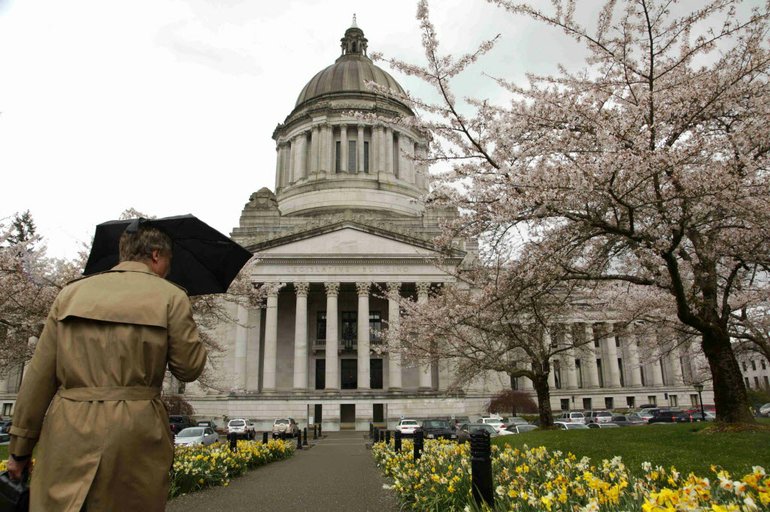OLYMPIA — The Washington Senate on Monday approved its proposed two-year state budget that slashes $4.8 billion in state spending, including deepening cuts to K-12 education.
The 34-13 vote sets up negotiations with the House of Representatives and Gov. Chris Gregoire’s office that will likely take the legislative session into overtime. The differences, few but large in money, between the House and Senate budgets seem too big to close between now and the end of session, currently scheduled to be Easter Sunday.
“Make no mistake, we cut and we cut deeply,” said Sen. Ed Murray, D-Seattle, chair of the Ways and Means Committee. “It is the deepest cuts and the lowest level of spending in decades. It has been a painful process and we have made very difficult decisions.”
The plan includes $4.8 billion in cost-cutting measures as it tries to fill in a $5.1 billion deficit in the next two-year period. It also includes more than $450 million in fund transfers, among other things, and leaves an ending balance of about $725 million.
Democrats hold a 27-22 majority in the Senate, with several moderate Democrats who have shown a willingness to work with Republicans. From the get-go, the Senate began writing its budget with significant influence for the Republicans. Democrats have a more stable majority, both in numbers and procedure, in the House.
“I’m happy to report to you this budget, for the first time in half a dozen years, does not spend more than what we have,” said Senate Minority Leader Mike Hewitt, R-Walla Walla. Hewitt added that the Senate budget puts the state on a more “stable” path of spending.
“I’m just hoping the House will stay with us,” he said.
Last piece of puzzle
The Senate budget is the last piece of the puzzle as lawmakers head for tough negotiations on state spending in the last days of the legislative session. Last week, Gregoire acknowledged that a special session is needed to finish all the work.
The Senate plan assumes $250 million in savings from wage reductions for teachers. But teacher salaries include a combination of local, federal and state money. Under the proposal, school districts would have to decide how to deal with the reduction in money. Last week, amid much criticism, a Senate panel replaced a plan to penalize school districts with high truancy rates — something budget writers assume will save another $95 million — with a plan to delay payments to school districts for buses, an idea presented by Gregoire in December.
On Monday, Sen. Rosemary McAuliffe, D- Seattle, chair of the Senate’s education committee, took responsibility for pushing the average class attendance budget cut, saying the backfire should have been directed at her.
“But I still believe it’s the right thing to do and I will work over the interim to study the seven states that are doing it to see if it made a difference in their attendance,” she said.
Still, combined for about $340 million, those two cuts to education are one of the key differences between the Senate budget and the House proposal, which didn’t include the teacher pay cut.
The House’s proposal, which cuts $4.4 billion in spending, included a plan to privatize the state’s liquor distribution, earning the state a projected $300 million. But that idea has not attracted support from Gregoire and it wasn’t included in the Senate proposal.
Only a handful of senators spoke about the budget Monday, mostly praising Murray and Sen. Joe Zarelli, R-Ridgefield, for writing a bipartisan budget.
Billions already cut
The state is struggling to recover from the impact of the Great Recession, and billions have been cut from the state budget over the last four years. In March, the state economist said Washington is projected to lose an additional $780 million in tax collections during the next two years.
The Senate plan mandates more furloughs for state employees, based on salary. Workers who make between $50,000 and $75,000 would see an extra 16 hours of furloughs, for example. It cuts more deeply into Disability Lifeline, a state program that aids disabled adults. Under the Senate plan, the program would see $180 million in savings from eliminating cash grants to program recipients. Instead, the program would switch to housing vouchers. The program also sees a reduction in enrollment in its medical program, for savings of more than $50 million.
The Basic Health Plan, the state’s health care program for the poor, would see a $122 million cut from reducing enrollment to 34,000 people in 2013.
About $1.2 billion in savings would come from not funding two education initiatives that increase teacher pay and reduce classroom sizes. Lawmakers have not funded these two voter-approved mandates during the recession.
Under the Senate plan, higher education sees a cut of about half a billion dollars. Like the House and Gregoire, Senate budget writers say the cut can be offset by yearly tuition hikes in the next two years at the state’s universities and colleges. Under the Senate budget, the University of Washington, Washington State University and Western Washington University would see 16 percent tuition hikes; Central Washington and The Evergreen State College would see a 14 percent increase; and community college tuition would go up by 12 percent.



